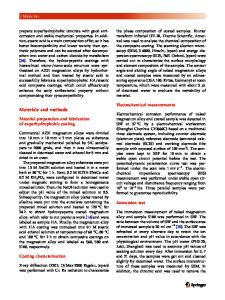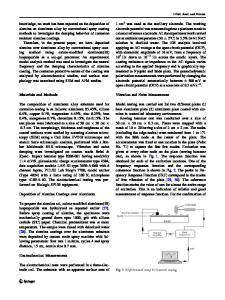Multiscale corrosion analysis of superhydrophobic coating on 2024 aluminum alloy in a 3.5 wt% NaCl solution
- PDF / 408,636 Bytes
- 7 Pages / 612 x 792 pts (letter) Page_size
- 75 Downloads / 367 Views
Research Letter
Multiscale corrosion analysis of superhydrophobic coating on 2024 aluminum alloy in a 3.5 wt% NaCl solution Divine Sebastian and Chun-Wei Yao , Department of Mechanical Engineering, Lamar University, Beaumont, TX 77710, USA Ian Lian, Department of Biology, Lamar University, Beaumont, TX 77710, USA Address all correspondence to Chun-Wei Yao at [email protected] (Received 16 January 2020; accepted 25 March 2020)
Abstract In this work, a facile superhydrophobic coating for 2024-T3 aluminum alloy is developed and characterized. The corrosion resistance of the coating was analyzed. The results showed that the coating has high polarization resistance and a low corrosion rate. Furthermore, a micro/ nanoscale investigation about the interaction between substrates and the corrosive environment was carried out using the in situ atomic force microscope technique. The change in surface topography was monitored for both the bare aluminum alloy substrate and the superhydrophobic aluminum alloy. The results showed that the coating retained surface features indicated that the coating has excellent corrosion resistance.
Introduction Aluminum and its alloys are among the most widely used metallic materials at present and offer a versatile combination of characteristic features such as low density, high thermal and electrical conductivity, excellent ductility, and affordable cost. Keeping these factors as selection criteria, aluminum and its alloys are first choice materials for numerous applications such as automotive components, heat exchangers, food containers, and airframes. Artificial superhydrophobic coatings for aluminum draw special attention, particularly in the case of practical applications such as in aerospace industry, due to the fact that these coatings could add functionalities such as anticorrosion,[1,2] anti-icing,[3] and self-cleaning[4] in addition to the characteristic features of aluminum and its alloys, as explained earlier. Superhydrophobic coatings for aluminum can be developed using different approaches such as the self-assembled monolayers,[5] physical and chemical vapor deposition,[6] template method,[7] chemical etching,[8] electro-spinning,[9] and nanocomposites.[10–14] It is scientifically proved that the two major factors that are responsible for the superhydrophobic behavior of a surface are its surface morphology and surface chemistry. More specifically stating, the surface should possess nano-/microscale roughness in terms of surface morphology and should maintain low surface-free energy in terms of surface chemistry.[15–17] Most of the fabrication techniques tend to incorporate different fabrication stages for the alteration of surface morphology, followed by surface chemistry, in a sequential manner.[18] In this work, a superhydrophobic coating is achieved by a single fabrication stage in which a nanocomposite-coating solution is applied onto the surface of interest. The nanocomposite-coating solution developed in this work
constitutes pretreated silica nanoparticles along with toluene
Data Loading...











